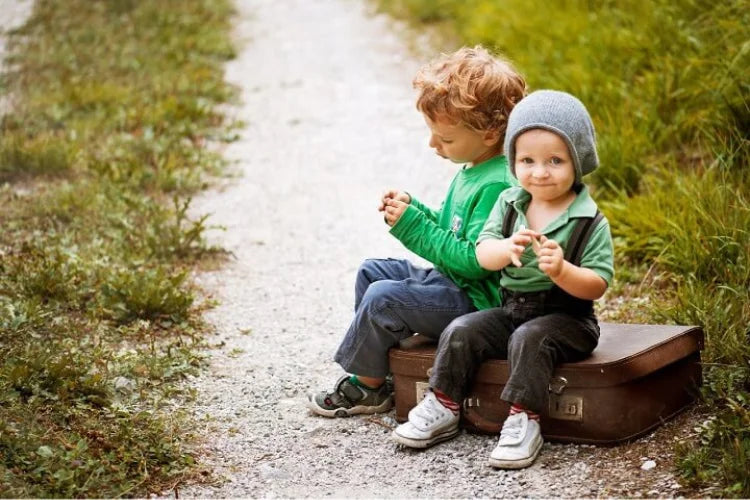There are few things that are more intimately connected to toddlers than their equipment and toys. Therefore, choosing the right items for your child is always one of the more important tasks that goes with parenthood. Sippy cups, in particular, require a delicate approach since they are used to feed and nurture your child for most of their early childhood. For that reason, it's only natural that you would want the best non-toxic sippy cup as part of their kit.
What is a Sippy Cup?
Sippy cup is best described as a transitional drinking equipment for children who are moving from baby bottles or breastfeeding to drinking from a regular cup. It is used to help toddlers develop the skills that are needed for drinking from a regular vessel. A sippy cup typically has a sprout or straw, as well as side handles for easier grip.
Do Pediatricians Recommend Sippy Cups?
Pediatricians may recommend the use of a sippy cup for kids aged 6 months up to 2 or 3 years. Although, this also varies depending on the child's development [1]. What experts do agree with is that prolonged use of sippy cups can delay the development of certain habits and activities. In some cases, pediatricians may also advise skipping sippy cups altogether.
Why are Sippy Cups No Longer Recommended?
Being convenient for both child and parent doesn't make a sippy cup necessary for each kid. On the contrary, some experts argue that extended use of such equipment can hinder a child's development.
Sippy cups are said to be a cause for delayed oral development. Sippy cups are suspected to affect speech production, swallowing efficiency and safety and the ability of a child to consume various food textures.
May Alter Speech Patterns
Allowing children to use traditional sippy cups for too long can cause tongue thrust. Kids with this condition develop a tendency to have their tongue rest farther forward than its natural position. In some cases, this can cause a lisp to develop.
Additionally, prolonged use of sippy cups may intervene with the natural development of oral motor skills, which are likewise critical for speech.
May Cause Teeth Problems
Drinking juice or milk out of a sippy cup is feared to cause cavities by trapping sugar in the child's mouth and teeth, which in turn leads to tooth decay. The tongue thrust that can get develop while using a sippy cup can also impact the toddler's bite pattern and strength.
May Delay Maturing Swallowing
As the baby matures, so too is their swallowing pattern. However, its development can be hindered by the constant use of a hard-spout sippy cup, which helps train a different pattern.
The babies' suckle-swallow pattern is meant to transform into a tongue-tip pattern that allows the consumption of food textures that are more advanced. Using a sippy cup, according to experts could thwart this development.
What are the Alternatives to Sippy Cups?
There are a few types of sippy cups you can consider as well as a host of familiar alternatives. In fact, you can even skip them altogether and gradually train your kid to drink using small open cups.
Spoutless 360 Cups
A 360 cup has a lid, but it also has a flat edge. This allows children to conveniently drink out of them at any point along the edge. This design makes for great training equipment on how to drink out of an open cup.
Open Cups
Instead of sippy cups and straws, you can start introducing small, open cups early on. This will help them develop the right behavior and skills they'll use for life. When choosing the material, avoid plastic cups and prioritize silicone or glass cups since these are often toxin-free.
Also, select cups with handles to reinforce your child's grip. To start, you can offer small amounts of liquid and gradually increase their intake depending on the kid's development. You can even use a shot glass to start their training since it's easier to grasp and sip from.
Straw Cups
Drinking from a straw can help kids develop the necessary oral motor skills and motion used for drinking from an open cup. You can also consider cutting the straw short so that only your child's lips go around it, not their tongue. For hygiene and general safety, we recommend choosing a spill-proof straw cup.
When Can You Introduce Sippy Cup Alternatives?
You can try introducing these types of drinking vessels when kids are seemingly ready to transition away from the bottle. Typically, this covers toddlers who are aged 9 months and beyond. By then, they should be moderately comfortable drinking from straws or small open cups.
What is the Safest Material for Kids to Drink From?
Being mindful of the materials used in equipment and toys for your baby is like an instinct that all parents eventually develop. But if you need a quick reminder or reference, then here are some of the things that should be avoided for general health and safety among the family.
No Plastic Parts
Plastic sippy cups can be easily avoided because there are numerous brands that make non-toxic sippy cups from glass or stainless steel. Some may have one or two plastic parts like the handles, but most of the cup is plastic-free.
No BPA/BPS
BPA (bisphenol A) and BPS (bisphenol S) are chemicals that have been used and developed in the production of plastics and have raised alarms about potential health effects. any articles to support this Thus, choosing a cup or any baby equipment for that matter, that is BPA/BPS-free is always a wise decision.
No PVC
Moving away from PVC (polyvinyl chloride) in baby drinking cups is recommended since it is known to contain additives like phthalates, which can leach into liquids and pose health risks. can you find journal to support this info?
No Phthalates
Young children are more vulnerable to the health risks brought by phthalates than adults. In this case, it's another reason to cross out a plastic sippy cup off your shopping list. In general, your family should avoid consumer goods that use phthalates, which are often used to make plastic products more durable and flexible.
No Reports of Heavy Metals
Heavy metals may contain lead, cadmium or mercury which is a big no-no for developing infants and toddlers. Instead of heavy metals, you can consider cups that are made from glass, stainless steel or silicone.
No Sippy Spouts
You can avoid sippy spouts or sippy cups by referring to some of the alternative drinking cups we've previously mentioned. Skipping sippy cups may require you to be more active in training your child to drink in open cups, but this should make their oral development more linear and efficient.
This website uses affiliate links which may earn a commission at no additional cost to you. As an Amazon Associate we earn from qualifying purchases.
Best Non-Toxic Sippy Cup Alternatives
The best non-toxic sippy cups and alternatives are those that are BPA- and PVC-free! They are also thoroughly tested to ensure that no amounts of lead, heavy metals or other harmful chemicals were used in making the equipment.

Munchkin’s Miracle Stainless Steel 360 Cup
Munchkin’s Miracle Stainless Steel 360 Cup is a plastic-free sippy cup that we love for its simple but ergonomic design. There are no small parts to worry about and the vacuum-sealed cup can even keep drinks cool for up to 15 hours.
Material: Stainless steel
Suitable for: Toddlers

Green Sprouts Glass Sippy Cup and Straw
The Green Sprouts Glass Sip and Straw Cup is all (Borosilicate) glass, silicone and synthetic rubber. Most notably, it's BPA- and PVC-free, which makes it all the more perfect for babies and toddlers who are just transitioning out of baby bottle and breast milk.
Material: Borosilicate glass, synthetic rubber, silicone
Suitable for: Toddlers
Green Sprouts Silicone Learning Cup
If you are confident about skipping straw-assisted cups and sippy cups, then the Green Sprouts Silicone Learning Cup is a safe choice for your baby's first open cup. It's made of silicone and features a pair of handles and a wide base for greater stability.
Material: Silicone
Suitable for: Toddlers

EZPZ Tiny Cup
When not in use, you'd be forgiven to think that the silicone EZPZ Tiny Cup is some kind of a display. But past that, we love the compact design that is surprisingly easy to grip even without handles. It's a great alternative over a traditional sippy cup.
Material: Silicone
Suitable for: Toddlers

Brave Justice Kids Co
The sturdy Brave Justice Kids Co collapsible container is easy to clean and convenient to carry around thanks to its overarching handle and compact design. It's 100% made of food-grade silicone that can safely keep liquids and snacks for hours.
Material: Silicone
Suitable for: Toddlers
Haakaa Silicone Toddler Cup
The Haakaa Silicone Toddler Cup with double non-slip handles is made with 100% translucent food-grade silicone. The thoughtful cutout for nose was a nice touch as it was able to allow the baby to drink out of the cup without leaning their head back.
Material: Silicone
Suitable for: Babies, toddlers

Elk and Friends Toddler Cup
The bright-colored Elk and Friends Toddler Cups are designed ala mason jars but use a stainless steel body and silicone sleeve for grip. The package also includes complimentary straw and air-tight storage lids.
Material: Stainless steel, silicone
Suitable for: Toddlers

Lifefactory 12oc Straw Bottle
The Lifefactory Straw Bottle is for general purpose and all age groups. Therefore, you can use this beyond the training years of your child. The body is made of glass while the grip is made of silicone. For starters, you can use the straw cup lid to supervise your toddler's transition to proper drinking cups.
Material: Glass, silicone
Suitable for: Toddlers

Pura Kiki Stainless Steel Sippy or Straw Cup
Pura Kiki Stainless Steel Sippy or Straw Cup is a catchy multi-use water bottle that made quite an impression on us. The body is made of stainless steel while the colored sleeve is pure silicone. The silicone straw can be swapped out for a silicone lid depending on the stage and progress of your child's training.
Material: Stainless steel, silicone
Suitable for: Toddlers

Thermos Foogo Insulated Stainless Steel Bottle
Thermos Foogo Insulated Stainless Steel Bottle features a stainless steel body and a pop-up silicone straw. But you'll definitely want this more for its insulation that can last up to 10 hours. Cleaning requires a bit more effort since you need to dismantle the bottle into 4 parts. But this also means that you can thoroughly clean and disinfect the unit whenever necessary.
Material: Stainless steel, silicone
Suitable for: Babies, toddlers

Kleen Kanteen Stainless Steel Sport Bottle
Kleen Kanteen Stainless Steel Sport Bottle is another entry that's suitable for all ages and water container purposes. It's a well-rounded drinkware that can also be used for training toddlers using its patented adjustable straw lid.
Material: Stainless steel
Suitable for: Toddlers

Grow with Me Non-Toxic Sippy Cup by Lifefactory
Lifefactory's Grow with Me Non-Toxic Sippy Cup is perfect for toddlers who are just getting into their transition to open cups. The kit comes with a variety of nipple sizes and sippy caps that can be adjusted to match your baby's development and age.
Material: Silicone
Suitable for: Toddlers
Pick the Best Non Toxic Sippy Cup That Works for Toddler
Whether you're using sippy cups or any recommended alternatives, it's important to remember that the goal is still all about helping your kid transition to open cups. Thus, you shouldn't be complacent and let them become too dependent on their training cup. The key is to constantly encourage the development of proper motor skills and drinking techniques, which sometimes requires a timely intervention until your toddler becomes fully comfortable as an independent drinker.
Reference List:
[1] S Ben‐Avraham, C Hyden, Bottle and sippy cup use is associated with diet and energy intake in toddlers, Maternal and Child Nutrition (2015).













